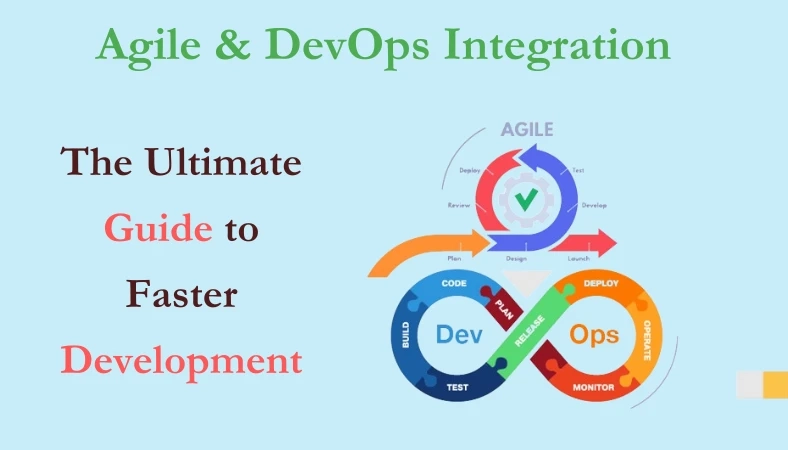In today's fast-paced digital landscape, there's an increasing demand for quicker software development processes. Agile and DevOps methodologies have emerged as leading approaches to meet this need. Agile focuses on iterative development and collaboration, aiming to deliver high-quality software in short cycles. On the other hand, DevOps emphasizes collaboration between development and operations teams, promoting automation and continuous integration/continuous deployment (CI/CD) practices to accelerate the software delivery pipeline. When Agile and DevOps are integrated, the potential for significant speed improvements becomes evident. By combining Agile's iterative approach with DevOps' automation and collaboration, teams can streamline development workflows, reduce bottlenecks, and deliver software updates more efficiently.
This ultimate guide explores how integrating Agile and DevOps can revolutionize software development, providing actionable insights and best practices for achieving faster and more reliable results.
DevOps and Agile Methodologies for Software Development
A. Agile Methodologies
Agile methodologies focus on iterative development, prioritizing customer needs, and continuous improvement. Teams work in short cycles, gathering feedback from customers regularly to adapt and refine their products. Popular Agile frameworks like Scrum and Kanban provide structured approaches to managing projects. Scrum emphasizes fixed-length iterations called sprints, while Kanban focuses on visualizing work and limiting work in progress. These frameworks help teams stay organized, collaborate effectively, and deliver high-quality software products efficiently.
B. DevOps Practices
DevOps is a culture and set of practices aimed at breaking down barriers between development and operations teams to streamline the software delivery process. Core DevOps practices include continuous integration (automating the build and testing of code changes), continuous delivery (automating the deployment of code changes to production), and automation (automating repetitive tasks). By implementing DevOps practices, teams can increase collaboration, improve communication, and deliver software updates faster and more reliably. Breaking down silos between development and operations encourages shared responsibility for the entire software delivery lifecycle, leading to faster feedback loops and better outcomes for both teams and customers.
Unlocking Faster Development with Agile & DevOps Integration
A. Alignment of Agile and DevOps Principles
Agile principles, such as short iterations and continuous feedback loops, complement DevOps practices by promoting rapid development and iteration. Both methodologies emphasize delivering value to customers quickly and responding promptly to changing requirements, making them natural partners in achieving faster releases and more efficient software development processes.
B. Benefits of Integrating Agile and DevOps
Increased Speed and EfficiencyIntegrating Agile and DevOps results in reduced development cycles and faster deployments. By streamlining processes and automating repetitive tasks, teams can deliver software updates more frequently, meeting customer demands and market expectations in a timely manner.
Improved Quality and ReliabilityThe combination of Agile's focus on continuous testing and DevOps' emphasis on automation leads to higher-quality software with fewer bugs. Continuous feedback loops allow teams to identify and address issues early in the development cycle, resulting in more reliable releases and improved customer satisfaction.
Enhanced Collaboration and CommunicationIntegrating Agile and DevOps breaks down silos between development, operations, and other stakeholders, fostering better collaboration and communication. By working together closely throughout the software delivery pipeline, teams can share insights, align goals, and make informed decisions, ultimately delivering better outcomes for the organization.
Navigating Challenges in Integrating DevOps and Agile
A. Acknowledging Integration Hurdles
Integrating Agile and DevOps can encounter obstacles that hinder seamless collaboration and implementation. Navigating the complexities of DevOps and Agile is important to ensure collaboration. Cultural shifts may face resistance from traditional mindsets accustomed to hierarchical structures, hindering teamwork and adaptability. Additionally, navigating tooling challenges involves selecting and integrating compatible tools that align with Agile and DevOps methodologies. Defining and measuring success metrics pose another challenge, as organizations must establish clear benchmarks to track progress and ensure the effectiveness of Agile-DevOps integration.
B. Practical Solutions for Overcoming Complexities
To overcome these complexities, organizations can foster a culture of openness and collaboration, encouraging teams to embrace change and adopt agile mindsets. Training and support for employees transitioning to new tools can alleviate tooling challenges, ensuring seamless integration and workflow efficiency. Furthermore, defining clear success metrics and regularly evaluating performance against these benchmarks promotes transparency and accountability, driving continuous improvement and innovation in Agile-DevOps environments.
Optimizing Costs in Agile & DevOps Integration
A. Dispelling Misconceptions
Contrary to popular belief, Agile and DevOps implementation need not be expensive. While there may be initial investments, the long-term benefits often outweigh the costs.
B. Cost Savings through Efficiency
By adopting Agile and DevOps methodologies, organizations can streamline their development processes, leading to faster delivery cycles and reduced errors. This increased efficiency translates into significant cost savings over time, as fewer resources are required to fix defects and address issues.
C. Upfront Investments
While there may be upfront costs associated with implementing new tools and providing training to teams, these investments are essential for enabling the adoption of Agile and DevOps practices. Additionally, organizations should consider the potential returns on investment, as the improved productivity and quality of deliverables resulting from Agile and DevOps integration can ultimately lead to substantial cost savings and increased competitiveness in the market.
Conclusion
Integrating Agile and DevOps methodologies offers a powerful framework for achieving faster and more efficient software development processes. By combining Agile's iterative approach with DevOps' emphasis on collaboration and automation, organizations can streamline their workflows, reduce errors, and deliver high-quality software rapidly. As businesses continue to navigate the evolving landscape of software development, embracing Agile-DevOps integration becomes essential for staying competitive in today's market.



